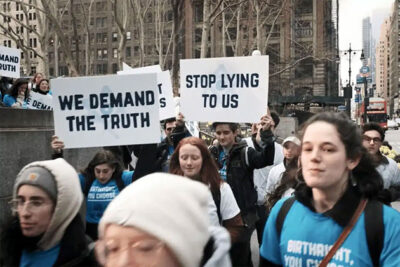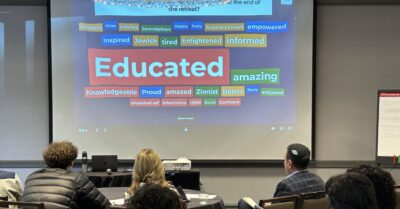In the Jewish world, the phenomenon exists where we often wait (procrastinate?) until Rosh Hashanah or perhaps a month earlier, at the start of Elul, to engage in deep personal reflection.
And there is a good reason for that, but if Elul and the beginning of Tishrei is the appointed time for personal reflection, then the national reflection for the Jewish people is actually happening right now.
We are currently in the middle of that period known as “the Three Weeks,” a time of collective reflection and mourning, which leads into Tisha B’Av.
This time in our calendar brings to mind the destruction of the First and Second Temples, the countless calamities our people have endured, and the ominous reality of antisemitism both in our history and today’s world.
But, this period also encourages us to examine our present, learn from our past, and envision the future we aim to shape.
Here’s a perspective that I’ve personally been grappling with. On the one hand, there’s never been a better time in history to be Jewish.
Consider this: Jews today enjoy unprecedented rights and have achieved remarkable success. Take this observation from David Brooks, writing in 2010:
Jews make up only 0.2 percent of the global population, but we’ve produced 54% of the world chess champions, 27% of Nobel physics laureates and 31% of medicine laureates.
In the U.S., we are 2% of the population, but we hold 21% of Ivy League seats and make up 38% of top philanthropists on a recent Business Week list.
(In the past several years, the percentage of Jewish students at the Ivies has decreased, with Jewish students making up 15.5% of undergraduates at these schools today.)
The Jewish people have their own state, which is a technological, military, financial and spiritual powerhouse.
Sounds pretty good, right? But at the same time, it’s a challenging era to be Jewish. In recent years, we’ve seen a troubling increase in antisemitism worldwide.
According to ADL, the U.S. alone recorded nearly 3,700 antisemitic incidents in 2022, which is a 36% increase from the previous year and the highest number on record since 1979.
There’s been a significant rise in antisemitic incidents in K-12 schools, colleges, and universities, not to mention Jewish institutions like synagogues and Jewish schools.
This stark contrast — the best of times and the worst of times — has me thinking. While we can’t and shouldn’t deny the rising tide of antisemitism, here’s what worries me:
Tying Jewish identity excessively with antisemitism can breed paranoia, erode our self-image, and overshadow so many other parts of a positive, proactive Jewish identity.
Of course, we must remain vigilant about the hatred for the Jewish people that at times feels ontological, but we should also focus on the positive aspects of our Jewish identity — Torah study, community, rituals, Shabbat, holidays, and the list goes on.
So, where do we strike the balance? Should we place more or less emphasis on antisemitism in our discussions? In our communities, our classrooms, and around our Shabbat tables, do we give it too much attention or not enough?
Typically, each week we share a Today Unpacked video and an article on current events, but this week we’re doing something a bit different.
We thought this introspective period in our calendar would be the perfect time to compile and share 12 of our videos on Jewish history, which explore the history of the Temples’ destruction, examples of expulsions and oppressions, and various facets of antisemitism.
Most of these videos are paired with educational resources for you to use with your students, your campers, your friends, your colleagues (and we’ll be adding resources for the rest soon).
But even as we face and explore antisemitism, let’s remember this: The path from the 17th of Tammuz to the 9th of Av — and eventually, the transformation of mourning into celebration — relies less on how others treat us, and more on how we treat each other.
As the Yiddish expression I recently read, courtesy of my good friend Rabbi Judah Mischel, reminds us: “When a brother acts like a brother, then a father will act like a father.”
I invite you to scroll down and watch our collection of videos. Each explores a different facet of antisemitism — conspiracy theories, the destruction of the Second Temple, Martin Luther’s antisemitism, Black Hebrew Israelite antisemitism, when criticism of Israel crosses the line into antisemitism.
The key takeaway? Antisemitism doesn’t come from a single source and isn’t a monolithic phenomenon. It’s a mutation that can exist everywhere.
While understanding this is something to reflect on during these weeks, let’s also remember that our ultimate measure lies not in how others treat us, but how we treat each other.
Videos and educational resources on antisemitism:
Why does antisemitism still exist?
Why is it that Jews experience a large percentage of the world’s hate crimes, despite being less than 0.2% of the world’s population? Use this video to explore why antisemitism still exists.
Whose fault is antisemitism?
Use this video to explore how antisemitism has always been spread by offenders across the ideological spectrum. That’s why it is key to focus on fighting antisemitic ideas and not get hung up on the identities of whoever is perpetuating them.
Do Jews cause antisemitism?
It may sound bizarre, but a shockingly large number of people believe that Jews cause themselves to be hated. Use this video and the accompanying resources to help your students understand why this claim is so egregiously wrong.
The origins of antisemitic conspiracies
Use this video to explore the antisemitic ideas we hear today, and help your students identify the conspiracy theories that drive them.
The conspiracy of the origin of Ashkenazi Jews
Use this video to explore a long-standing conspiracy theory claiming that Ashkenazi Jews are descendants of the Khazars, a Turkic-speaking people in the Middle Ages who are thought to have converted to Judaism at the instruction of their ruler. This theory has been thoroughly debunked, so why does it continue to resonate with celebrities like Kanye West and Kyrie Irving?
Are Hebrew Israelites the real Jews? (Educational resources coming soon)
Use this video to explore the radical Hebrew Israelite Movement, a group that is notorious for their hateful and antisemitic views. As these antisemitic views have spread, so has a rift between two communities that should have a strong bond over shared histories, but are instead divided and afraid.
Are Jews rich?
Antisemitic tropes about Jewish wealth have been around for centuries. Use this video to help your students understand these harmful stereotypes and explore the question: Are Jews rich? While not all Jews are rich, Jewish people are statistically overrepresented in many industries.
How the Protestant Reformation affected Jews
The 16th-century German theologian Martin Luther is most well-known for initiating the Protestant Reformation. But there’s a more sinister part of his legacy. Use this video to explore how Luther’s antisemitic ideas triggered a wave of anti-Jewish violence, permanently altering the course of Judaism.
Have Jews really been expelled from 109 countries? (Educational resources coming soon)
This video explores the antisemitic trope that Jews have been expelled from 109 countries. While it’s true that Jews have been expelled from several countries over the centuries, the exaggerated antisemitic claim of 109 countries serves as an ongoing excuse for neo-Nazi Jewish hatred.
The Judean Exile to Babylonia
Use this video to explore the history of the destruction of the First Temple and the Judean exile to Babylonia. In this tumultuous chapter of history lies several possible answers to the question: What is the secret of Jewish survival?
The Great Jewish Revolt
Use this video to explore the period when the Romans destroyed the Second Temple and dominated the Holy Land. Only a couple of generations later, another failed revolt and wave of persecutions decimated the ranks of the sages, leaving the Jewish people with few teachers and dismal prospects for Jewish continuity.
What happened during the Spanish Inquisition? (Educational resources coming soon)
Today, both Spain and Portugal are religiously tolerant democracies. But both countries have a dark history of religious persecution. Use this video to explore what actually happened during the Spanish Inquisition and whether any government can really atone for the sins of the past.





